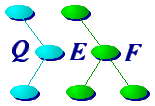 |
|
| Chapter 8: Qvrs: The QEF Variables System |
 |
qvrs is the major configuration system of the QEF system.
qvrs variables are used to define search paths,
tool names and flags, semantic options, qef controls,
and miscellaneous application flags and controls.
This chapter briefly describes the qvrs files,
their syntax, semantics, and processing and that
of the associated tool traits.
|
| Chapter 9: Qsg: The Principal QEF Script Generator |
 |
A unique and important feature of the QEF system is its use of
script generators to create the input for the back end.
The most frequently used script generator is qsg, which is
introduced in this chapter.
The associated tools and most commonly used qsg-library functions
are briefly described.
|
| Chapter 10: The File System Integrity Check (FSIC) System |
 |
The File System Integrity Check (FSIC) package is a combination of
files, programs and a qsg script that aid in the maintenance of
databases of the source, object, and installation trees.
The use of this package protects the health of a software product.
This chapter introduces the FSIC package and explains how to
initialize its database.
|
| Chapter 11: Advanced Tools |
 |
The QEF product's bin directory contains 214 different programs
(259 counting links)
-- see Appendix D: Q-Tree Command Summaries.
This chapter presents some of the more useful tools that are not
directly associated with software construction, but are very useful
in controlling and monitoring builds across the network.
|
| Chapter 12: QEF and Large Projects |
 |
The process of converting a project to be built with the QEF system can
be as simple as creating a single file containing as few as two lines.
However, converting a major project requires planning and an
appreciation of some of the relevant issues.
This chapter discusses some of those issues and possible approaches to
solving the problems inherent in large scale or complicated projects.
|







